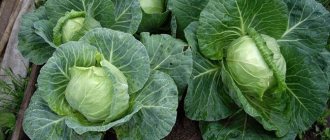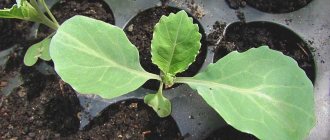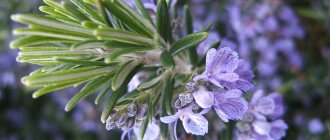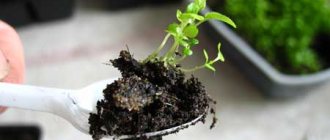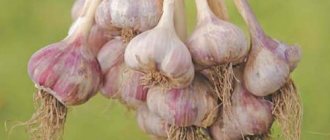Cauliflower has recently become a staple in our gardens, but confidently competes with other types of cabbage. A native of the warm Mediterranean, she has perfectly adapted to the cold climate of the Urals and Siberia, and even to the conditions of white nights in the Leningrad region. But many gardeners have a main problem when growing it - the head does not set, and as a result they do not receive the promised harvest. How to grow cauliflower so that the harvest pleases you? Knowing some of the features of its cultivation, it is not at all difficult.
Biological features
Knowing the biological characteristics of a crop, you will not make mistakes in its cultivation in the future.
- This is a plant with an annual growing season. The head - the head - is nothing more than a crowded flowering shoot. If you are late in harvesting, even by a few days, the inflorescences in the head will separate, begin to bloom, and later produce seeds.
- Cauliflower is a heat-loving plant. Cultivation requires compliance with a temperature range of no lower than 10º and no higher than 25ºС. At low temperatures, the cabbage may not set, or the cabbage will grow small and coarse-fibered. In hot weather, the head of cabbage will set, but will be loose.
- Cauliflower has a weak, fibrous root system, so the surface layer of the soil must be fertile and well-moistened, otherwise you will not get tasty cabbage.
- Sufficient daylight and darkness are necessary for growth. In the light, the head sets faster, but at the same time, with a shortened daylight hours, the heads of cabbage grow dense and large. Therefore, choose a well-lit bed.
Cauliflower is usually white in color. But now there are varieties of orange, purple, and green. But this does not affect the beneficial properties of the vegetable. Thus, orange cabbage varieties contain 25 times more vitamin A than their white counterparts, purple cabbage varieties contain more anthocyanins, and green cabbage varieties contain more antioxidants.
Preparation of planting material
Seed preparation is also important. To get strong, strong seedlings, you should take only large seeds. This way you can increase productivity by 30%. If you preheat the seeds, you can get even stronger seedlings. To do this, the seeds are placed in a fabric bag and immersed in warm water for 20 minutes. The water temperature should be 50 degrees.
After heating, the material is dried and etched. At home, you can disinfect the seeds by treating them with garlic juice. For this, 1 tsp. freshly squeezed juice mixed with 3 tsp. water and keep the seeds in this solution for 1 hour.
Cauliflower seeds prepared in this way are used for sowing.
Growing cauliflower at home
When growing cabbage on your plot, you should always remember its biological characteristics and try to adhere to them. Next, when purchasing seeds, keep in mind that varieties are divided into several types:
- for early spring,
- summer,
- autumn planting.
That is, during the season you can grow more than one cabbage crop if you follow the requirements of agricultural technology:
- choice of location,
- previous cultures
- growing methods (through seedlings or direct sowing in the ground),
- observing daylight hours,
- organization of watering,
- feeding,
- control of diseases and pests.
Selecting a location
First of all, the soil must be fertile; it requires basic nutrients: nitrogen, phosphorus, potassium. The absence of one of them may prevent the head from setting. Or complex mineral fertilizers. To get a large head, you need to build up a powerful leaf apparatus. It should be borne in mind that the head is mainly formed after the leaves have developed well, and their growth is uneven.
Predecessors of culture
Cabbage will give a good harvest after good predecessors.
- Good ones are cucumbers, carrots,
- satisfactory – onions, tomatoes,
- bad - all cruciferous crops, including cabbage cannot be planted for two seasons in a row.
After you have taken a place, you should choose a cultivation option: through seedlings or directly into open ground.
Landing dates
Depending on the climate of the region and desire, cauliflower can be grown throughout the season. When buying seeds, look at the ripening time, since the inflorescences grow quickly and if they are not cut off in time, the taste and presentation of the vegetable are lost. Therefore, plant cabbage in small batches at intervals of 2-3 weeks. Considering that the average ripening period is 90-100 days, the planting dates are as follows.
- When planting seedlings in the second ten days of March, the first harvest is already harvested in June;
- First ten days of April - cabbage will ripen by mid-July;
- Late April - early May, cabbage planting and harvest in August for winter preparations.
Preparation of land and containers
This vegetable crop is demanding on fertility and any soil mixture will not suit it. The soil for it must be prepared thoroughly, otherwise the plants will feel a lack of nutritional elements, and the seedlings will grow weak and not viable.
To make up the soil, the following substances are taken in equal quantities:
- turf land;
- high peat;
- rotted manure.
All these components are thoroughly mixed, and the mixture is placed in boxes. Then the soil is fertilized with double superphosphate at the rate of 20 g per m2, and then the soil composition is disinfected by spilling it with a slightly pink solution of potassium permanganate.
Important! In order to prevent seedlings from becoming infected with blackleg, you need to prepare river sand by first calcining it over a fire. It will be needed to fill the soil after sowing the seeds. As a last resort, you can use ash instead.
Growing seedlings in peat tablets
Growing seedlings in peat tablets is very convenient. The advantage of this method is that picking is eliminated, thereby saving time.
Planting seeds
First, the peat tablets are soaked in water. Place them in a container and fill with water. It is better to take well water, not chlorinated. Wait a bit for the tablets to swell. Then the middle of the tablet is compacted with a finger and a small bed is made. This is necessary so that after sowing the seeds do not go deep into the ground and may simply not sprout.
Using a toothpick dipped in water, pick up a cabbage seed and transfer it to the prepared hole. Then the seed is covered with soil along the edges of the tablet. The seeds should eventually end up at a depth of 1 cm. The container with the sown peat tablets is covered with a transparent lid or film and placed in the warmest place in the apartment. After 4-5 days, the first shoots should appear.
Growing temperature
As soon as the first shoots appear, the container with the tablets is transferred to a cool place. For the first 5-6 days it is recommended to keep them at a temperature of 6-8ºС so that they do not become pampered and stretch out. Your harvest will depend on this in the future.
And only after 5 days the temperature can be gradually increased and brought to 20-22ºС, but no more. It is quite difficult to do this at home, so you can use agricultural lamps.
Since the nutrition in peat tablets becomes insufficient, every 10 days the seedlings are fed with complex fertilizers.
Transfer
Another 15 days have passed, the first true leaves appear on the seedlings. This means that it’s time to transplant into separate cups. The seedlings no longer have enough nutrients.
First, prepare the soil.
- Purchased soil - 4 parts,
- Vermicompost – 1 part,
- Vermiculite – 1 part.
The soil is mixed and a little is poured onto the bottom of the prepared cups.
Vermiculite plays the role of a soil loosening agent; in addition, watering with it is reduced, since it absorbs excess moisture, and when necessary, on the contrary, gives it away.
The outer film is carefully removed from the tablets. The seedlings are placed in cups, sprinkled with soil on the sides up to the seven-lobed leaves, lightly compacting it so that there are no voids. Then water it with water, preferably with the addition of biological fungicides.
Feed the seedlings once a week with complex fertilizers, or dissolve 15 g of potassium and 5 g of urea in 10 liters of water. Seedlings are illuminated for up to 14 hours under fluorescent or phytolamps.
Planting seedlings in the ground
The ideal age of seedlings for transplanting into open ground is 40-45 days. There is no need to keep seedlings in cramped cups. Otherwise, the heads will set very early and will be small.
The cabbage bed is filled with compost and dug up. Make holes 20-30 cm deep, the distance between them is 40-50 cm.
The nutritional mixture is made:
- 5 liters of vermicompost,
- Saprogel (it improves soil quality) – 2 cups,
- Nitrogen fertilizer (granulated horse compost) – 1 cup,
- Universal fertilizer based on bone and fish meal - 1 cup,
- Cialite (source of silicon) – 2 cups.
A handful of nutrient mixture is poured into each hole and mixed together with the soil in the hole. The seedling is carefully taken out of the glass, placed in the hole, buried down to the first leaves. Then the seedling is watered.
Soil preparation
This crop reacts very sensitively to nutrient deficiencies in the soil. Therefore, the soil mixture for sowing seeds must be carefully prepared.
For cauliflower, you can prepare a substrate consisting of:
- 1 part turf;
- 1 part humus;
- 1 part peat.
When mixing the substrate, it is useful to add a little phosphorus, for example, superphosphate.
Before sowing seeds, the soil should be disinfected. To do this, it is spilled with a weak solution of manganese. To prevent the sprouts from getting blackleg, sprinkle a thin layer of calcined sand on top of the prepared soil mixture after sowing the seeds. Sand can be replaced with wood ash.
Growing seedlings in a greenhouse
You can grow seedlings in a polycarbonate greenhouse. I like this method better. Snow melts faster in a greenhouse. And in the spring, when the air outside is not particularly warm, the temperature inside the greenhouse will be optimal for the growth of seedlings. They do not stretch out and grow strong.
The soil should be fertile, light and breathable. In the bed, grooves are made with a depth of no more than 1 cm. The distance between the rows is no more than 10-15 cm. Seeds are sown at the bottom of the rows as rarely as possible, so that later when replanting they do not have to be thinned out. The top of the bed is leveled and watered abundantly from a watering can. In the future, watering is carried out as needed.
Caring for seedlings involves weeding and loosening row spacing. To make the seedlings more stable and not fall, the plants are hilled up during loosening to form additional roots. There is no point in fertilizing, since the seedlings receive enough nutrition from the soil. As soon as the real 3-4 leaves grow, the seedlings are transplanted into a garden bed in open ground.
Basic methods
There are two ways to grow strong and healthy seedlings on a windowsill: by sowing seeds in boxes or in peat pots. The only problem when growing cabbage seedlings is the very fragile root system.
Be sure to use a very loose substrate for sowing seeds, in which the delicate roots will grow freely. It is precisely because of the great fragility of the roots that summer residents most often sow seeds in peat pots so as not to injure the root system when planting. Many also use a mixed method - first you need to sow the seeds in containers, and then plant them in peat cups.
Growing cauliflower from seeds in open ground
First of all, choose a place where cucumbers or carrots grew last season.
At the beginning of May, as soon as the opportunity arises and the snow melts, the bed is prepared. The soil should be fertile and loose. Dry seeds are sown directly into prepared soil. If the seeds are untreated, they can be soaked for several minutes in a solution of potassium permanganate, then rinsed with water and dried.
Make furrows 1 cm deep in the garden bed, level them with soil and water them if necessary. Arcs are placed on the bed, and the top is covered with spunbond with a density of 42-60 g/sq.m. m. Then only watering and waiting for seedlings is carried out. The emerging seedlings, of course, are a little behind those planted with seedlings. But then the seedlings quickly catch up with them, they gain strength and become hardened.
When the cabbage has grown to 10 cm, the thickened plantings are thinned out, leaving a distance between seedlings of up to 20-25 cm. To do this, the excess seedlings are carefully dug up with 2 shovels along with a lump of earth and transplanted to another convenient place.
Planting seedlings in a garden bed
In order to properly plant the seedlings of this vegetable in the garden bed, the soil is prepared in the fall. After harvesting the predecessor, the bed is dug up to a depth of 25 cm, simultaneously clearing out the rhizomes of perennial weeds and plant debris from the beds.
Before the autumn digging, humus must be added at the rate of 8 kg per m2. In winter, it would be wise to push snow onto the bed so that in the spring, when it melts, it saturates the bed with moisture.
In spring, shortly before planting, fertilizers are distributed to each m2 of beds in the following volumes:
- ammonium nitrate - 30 g;
- potassium chloride - 20 g;
- superphosphate - 50 g.
After spreading the fertilizer, on the same day, the beds should be dug up, carefully breaking up the earthen lumps.
For seedlings, dig holes to a depth slightly greater than the height of the pots. The planting scheme depends on the early maturity of the variety:
- early cabbage is planted according to a pattern of 70 by 25 cm;
- varieties belonging to the mid-season group are planted according to a 70 by 30 cm pattern;
- late varieties are placed according to a 70 by 40 cm pattern.
At the time of planting the seedlings, 10 g of ash is placed in the hole, after mixing it with the ground. Then 1 liter of water is poured into the hole and the plants are planted. Seedlings in pots or without them are buried in the ground up to 1 true leaf. At the final stage, the planted seedlings need to be watered well. For better survival, it is recommended to shade the seedlings from the scorching rays of the sun for 3 days.
After 6 days, the plantings are inspected and fallen plants are replaced with new ones. Next, you will need to land in a timely manner:
- water;
- feed;
- weed;
- spud.
Caring for cauliflower after transplanting
Watering
Water the planted seedlings as needed, approximately once every 3-4 days, if there is no rain at this time. Excess moisture is also harmful to the roots and can cause the development of fungal diseases. By applying fertilizing, we also moisten the soil.
It is better to water from a watering can, irrigating the plants with water from above. Cabbage really likes this kind of watering.
Feeding
Cauliflower, more than other types of cabbage, needs to be fertilized with organic and mineral fertilizers. Feed the plants 3-4 times.
- The first feeding is carried out 10-12 days after rooting of seedlings. Water with a solution of mullein or chicken droppings at the rate of 1 liter per bucket of water. Nitrogen fertilizers are necessary to increase leaf mass.
- After 2 weeks, carry out a second feeding with the same solution, but adding a glass of wood ash to it.
- Once the head begins to form, it no longer needs nitrogen. Now they are fertilized with an ash solution. 2 cups of ash are diluted in a bucket of boiling water. As soon as the solution has cooled, water the cabbage with 0.5 liters per plant.
In addition, cabbage must be fed with fertilizers containing microelements. Fertilizers containing Cialite are used as a source of silicon. To fertilize with boron, use regular boric acid purchased at a pharmacy. A 10 g bag of boric acid is diluted in a small amount of hot water (not boiling water), stirred, added to a watering can with water and watered the plant.
Protecting inflorescences from the sun
Cauliflower inflorescences, when exposed to sunlight and heat, acquire a greenish, pinkish, purple or other color and lose their marketable value. To preserve the tender white heads, they must be covered by bending and breaking the outer leaves or tying them in a bunch above the head.
When buying seeds, make sure that the package contains the inscription: “The cabbage head is completely covered with inner leaves” or “Excellent self-covering ability.”
Care
Caring for grown seedlings consists of the following important work:
- feeding;
- watering;
- maintaining temperature;
- hardening.
Important! All this work is carried out in a complex manner, taking into account the requirements and recommendations, otherwise it will be difficult to grow good planting material.
Fertilizer
The roots of this cabbage, in comparison with white cabbage, are less developed and go deeper to a smaller depth. During the growing process, seedlings must be fed at least twice with mineral fertilizers.
The first foliar feeding is carried out in the phase of 2 true leaves. The working solution is prepared as follows:
- take 1 liter of warm water;
- 1/2 teaspoon of complex fertilizers is dissolved in this volume of liquid;
- After mixing, the solution is ready for use.
The seedlings are treated with the prepared solution.
The second foliar feeding begins approximately 12 days after the first. To do this, first prepare a working solution:
- dissolve 1 tbsp in a bucket of water at room temperature. l. urea;
- add to the composition 1 tbsp. l. potassium sulfate;
- Stir the mixture until the ingredients are completely dissolved.
The prepared solution is used to treat the seedlings leaf by leaf.
Hardening
The operation associated with hardening is intended to obtain seedlings that are strong and resistant to cold. It begins to be performed 13 days before placing the seedlings in the garden beds.
The essence of hardening is that in the spring, on warm days, seedlings growing in boxes or pots are taken to a loggia or an unheated greenhouse, where the temperature is maintained at +5 degrees. During cold nights, it is brought back into the warm room.
6 days before planting, they begin to leave it in the greenhouse at night. If the weather becomes warm during the day, you can open all the doors and windows in the greenhouse to bring the cabbage growing conditions as close as possible to those in the garden.
After two weeks of hardening, the seedlings are planted in open-air vegetable beds.
Watering
An important and responsible part of caring for seedlings is watering. It is necessary to irrigate moderately, since excessive watering can cause the development of diseases. And due to insufficient watering, cabbage may develop dwarf heads.
There are no differences between watering cauliflower and white cabbage. Water with water at room temperature after the soil has dried. To maintain optimal soil moisture, it is enough to water 1 time every 3 days.
8 days before planting the seedlings, they stop watering them. Before removing seedlings, in order to reduce trauma to the roots, the soil under them is irrigated abundantly.
Important! Too frequent watering or large watering rates can cause seedlings to become infected with blackleg.
Temperature for successful cultivation
And, of course, to obtain good and healthy seedlings, you will need to strictly comply with the temperature requirements. During the process of growing seedlings, the temperature will not be the same, since different phases of seedling development require different temperatures.
- To ensure that the seeds hatch quickly, the temperature is kept at +20 degrees until germination. If the seeds are sown in a greenhouse, to maintain the technological temperature at night, straw mats or old blankets are placed on top of the film or glass frames in the evening.
- If, after germination, the seedlings find themselves in conditions with elevated temperatures, they will begin to stretch out and become thinner. Good seedlings, however, will not work. Therefore, after the germination phase, the temperature in the nursery is sharply reduced to +8 degrees during the day and 2 degrees less at night. This temperature regime is maintained for 7 days, this will allow you to obtain seedlings with thick and strong stems.
- Then the temperature is increased to 12 degrees and maintained at this temperature until picking.
- After the picking procedure, the temperature can be increased by another 6 degrees, maintaining 18 degrees during the day and 16 degrees at night.
Diseases and pests
Cauliflower is often affected by diseases:
- Mucous bacteriosis,
- Blackleg,
- Kila,
- Downy mildew,
- Vascular bacteriosis.
Pests:
- Cruciferous flea beetles,
- Cabbage flies
- Secretive proboscis
- Aphid,
- fly moth,
- Sovka et al.
Plants that receive elements for their growth and development in time become resistant to diseases and pests.
Pest Control
The crop may suffer from fungal diseases. If signs of fungus are observed, then it is necessary to treat the seedlings with a special preparation “Fitosporin”. The drug is able to fight the pathogen directly. Caterpillars of cabbage whites and cabbage cutworms are also dangerous to cabbage. To combat such a parasite, you need to use the biological product “Enterobacterin”. An infusion of burdock leaves is considered to be an effective remedy.
To prepare the infusion you will need:
- 1/3 of a bucket of burdock leaves;
- water.
The infusion should stand for about a day.
Harvesting
The cabbage is ripe when its head is a tight ball. The weight of the cabbage by this time corresponds to that stated on the package with seeds (1.5-2 kg). It is important not to miss time for cleaning, otherwise the inflorescences will disintegrate and bloom.
Cut the heads of cabbage with a sharp knife under the outer leaves. To keep cauliflower fresh longer, do not remove all the leaves at once, cut off only the largest ones. It is better to transport the cabbage with the remaining leaves; it will not be damaged during transportation. With leaves, the shelf life of the head of cabbage will increase to 1.5-2 months.
If the head of cabbage is small, do not rush to cut it, leave it for a few days, it will grow some more. However, control this process, otherwise you may miss cleaning time.
Have a good harvest!
At what distance should I plant cabbage seedlings?
Required distance between cauliflower seedlings
- Early varieties of cauliflower should be planted at a distance of 25cm from each other and 70cm between rows.
- Late varieties of seedlings are planted at a distance of 35 cm from each other and 80 cm between rows.
We hope that thanks to our tips, you will be able to grow gorgeous cauliflower seedlings.
Most popular varieties
To get a harvest from the beginning of summer right up to the frost, you need to plant cauliflower varieties of different ripening periods. There are now so many varieties and hybrids that it is impossible to even mention them all, but you need to have an idea of the most popular ones, loved by the majority of gardeners. Among the early varieties, these are, for example, Snezhinka, MOVIR 74, Amphora with a ripening period from sowing to harvest of 2.5–3.5 months. And the latest varieties that can bear fruit until late autumn are Adler Winter, Romanesco, etc.
In addition, the following varieties of cauliflower are often planted in amateur gardens:
- mid-early variety Snowball 23, forming white heads weighing up to 1000 g. Suitable for freezing, the taste is characterized as excellent;
- mid-early variety Amethyst, producing large purple heads with high consumer qualities;
- Snezhana is an early ripening variety, the head is flat, white, weighing up to 2 kg. It is characterized by stable yield, high taste, resistance to diseases;
- the ultra-early variety Malimba, which forms very large white heads of high density within 2 months after planting the seedlings in open ground, is recommended for cultivation in any climatic conditions;
- medium-ripening variety Domestic, characterized as a productive variety, although one can argue with this: the maximum weight of the heads does not exceed 800 g, 4 months pass from sowing the seeds to harvesting;
- the Asterix F1 hybrid of medium ripening is famous for its increased resistance to diseases and vagaries of weather, the heads are white, weighing up to 1000 g;
- the Flora Blanca variety, of Polish origin, produces rapidly ripening harvests (vegetation period is about 4 months) of light yellow heads slightly above average size, cold-resistant, suitable for long-term storage;
- representatives of the late varieties Consista, Autumn Giant and Regent, stay in the garden for a very long time, so they are mainly planted in the southern regions. Late varieties are famous for producing very large heads, weighing up to 3 kg.
Picking up seedlings
There is an opinion that picking is undesirable for cauliflower for many reasons. Firstly, the tender seedlings of this vegetable endure such a procedure very painfully. Secondly, the fibrous root system formed after picking does not allow deep loosening of the peri-root circle. Thirdly, the time allotted for growing seedlings is not that long - 25-35 days, which allows the plants in the container not to compete with each other before planting in the ground.
If, nevertheless, the seedlings have stretched out and clearly do not have enough space, then you should resort to picking. This procedure is carried out at the stage of the appearance of the first true leaf. The seedlings are removed from a common container and transplanted into separate peat-humus or plastic cups filled with a mixture for seedlings. Seedling of sprouts is carried out along the cotyledon leaves
Tasty and healthy
The inflorescence head of cauliflower contains an incredible amount of vitamins and microelements. During the growing season, the vegetable accumulates so much vitamin C that even after undergoing heat treatment, 100 grams. of the product are able to completely fill the daily need for it. Cauliflower is also rich in folic acid, biotin, beta-carotene, and pyridoxine. Since cauliflower is an inflorescence, it, unlike cabbage, contains much more microelements such as potassium, magnesium, calcium and phosphorus. More recently, tartanic acid was discovered in cauliflower, which prevents the division of fat cells, so sufficient consumption of this vegetable from childhood can prevent obesity. The ability of cauliflower juice to regulate sugar levels in the body is also unique, which makes it indispensable in the diet of people with diabetes.
Separately, it is worth noting the ability of cauliflower to be easily digested. This property has made cauliflower the most important vegetable in the diet of children, in which it is very important to combine a small quantity with a high quality product.




